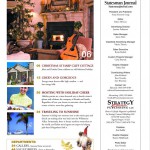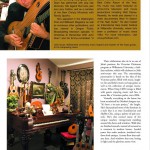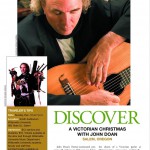Recently, John Doan was featured on Oregon Art Beat for Oregon Public Broadcasting. The show featured John performing on the harp guitar and harpolyre, and touring his studio and collection of rare and antique stringed instruments.
The “Expanded” Harp Guitar – Adding Possiblities with Super-Trebles
In Volume 7, Issue 1 of harpguitars.net, John Doan wrote the article, ‘The “Expanded” Harp Guitar – Adding Possibilities with Super-Trebles.’
The playing and making of harp guitars today is causing a re-examination of many basic design features that go into making a fine guitar-like instrument with an expanded range. The six-string guitar world is alive and vital today but with the addition of sub-basses and super-trebles entirely new dimensions and fundamental questions arise that are not being commonly discussed among six-string guitar builders. I have concluded that after reviewing and playing many prototype designs today that simply having skills as a six-string guitar builder is not going to result in a great harp guitar. Harp guitar construction in many ways is a very different activity than building a six-string instrument.
The article examines the construction, enhancement, and benefits the super-trebles add to the harp guitar as he discusses the theory and techniques used to create the Sullivan/Elliott harp guitar John developed.
The Inevitable Harp Guitar: Recurring Cycles in Guitar Evolution
 “The Inevitable Harp Guitar- Recurring Cycles in Guitar Evolution” was published in Fingerstyle Guitar Magazine No.66, and is used here with permission. For more information on harp guitar history go to harpguitars.net.
“The Inevitable Harp Guitar- Recurring Cycles in Guitar Evolution” was published in Fingerstyle Guitar Magazine No.66, and is used here with permission. For more information on harp guitar history go to harpguitars.net.
Back in the early 1970’s in my college studies on guitar I was very taken by the music from the renaissance and baroque eras and was intrigued that much of the material was originally intended for instruments beyond six strings. Having played twelve-string guitar and a double neck electric guitar in bands multi-stringed instruments seemed familiar to me. Just out of school I got an eight-course renaissance lute as well as a fourteen-course theorbo to play original lute music and included them in my guitar concerts.
Over time I began to recognize all sorts of multi-stringed instruments in some music shops, museums, and in books on instruments and was curious that hardly anyone played them or even seemed to know much about them. There were various lute-guitars (a.k.a. “lutars”) from late 19th/early 20th century Germany (those who think poorly of them call them “gututes”), Basse-guitares or Schrammel guitars from Europe (especially from Sweden, France, Germany, Italy and Eastern Europe), and harp guitars from early 20th century America.
These guitars all had an extended bass range with up to twelve additional strings. I even found a harp guitar made by Chris Knutsen in Port Townsend, Washington from the late 1890’s with seven additional super-trebles attached to the right of the ordinary six strings of the guitar. In time I acquired a Gibson harp guitar (literally hundreds were made in Gibson’s first twenty years), a Dyer harp guitar (made by the Larson brothers and still popular today especially since adopted by such great players like Michael Hedges and Stephen Bennett, among others), and various lesser known makes. I finally commissioned a twenty-string harp guitar (perhaps the first modern constructed harp guitar design in our times) from John Sullivan and Jeffrey Elliott of Portland, Oregon in 1985 and haven’t looked back since. *(note: William Eaton was building amazing multi-stringed creations of his own even before this). Continue reading
Preview of A Celtic Pilgrimage Documentary
Filmed entirely on location in Ireland, this is a preview of the upcoming documentary on John Doan’s “A Celtic Pilgrimage.” It showcases the journey he took repeatedly to explore the Celtic history and spiritual places he calls the “thin places” where spirit and earth meet.
John talks about the project and the stories of how he came to compose the beautiful music behind his Eire – Isle of the Saints, Wayfarer, and A Celtic Pilgrimage albums.
John Doan Plays 20 String Harp Guitar for Fellow Celtic Pilgrams
In an ancient cottage on Aran Isle in Ireland, John Doan plays for his fellow pilgrims on his own pilgrimage after completing the album, “Eire – Isle of the Saints.”
John Doan Performs Farewell on Harp Guitar at GAL Festival
At the 2006 Guild of American Luthiers Festival (GAL) in Tacoma, Washington, John Doan performs his best known tune, “Farewell,” from his A Celtic Pilgrimage and Eire – Isle of the Saints.
John Doan Performs at 2006 GAL Festival
At the 2006 GAL Festival in Tacoma, Washington, John Doan dazzled audiences with his harp guitar in this collection of tips from the Guild of American Luthiers Festival.
John and Deirdra Doan featured in Home and Lifestyle Magazine
 In the November/December 2006 issue of Home & Lifestyle magazine for the Willamette Valley, my wife and I were featured on the cover. Our home was decorated from top to bottom for Christmas in the middle of August. My wife, Deirdra, worked overtime to make our home warm, wonderful, and inviting for the holiday season.
In the November/December 2006 issue of Home & Lifestyle magazine for the Willamette Valley, my wife and I were featured on the cover. Our home was decorated from top to bottom for Christmas in the middle of August. My wife, Deirdra, worked overtime to make our home warm, wonderful, and inviting for the holiday season.
2005 International Harp Guitar Fesitval
In 2005, I hosted the third International Harp Guitar Festival (Sept. 3-4) at Willamette University where I am a professor of music. The event managed to attract a large crowd consisting of many students, faculty and staff, and members of the community nearly filling Hudson Hall for the evening concert.
We had just over 71 people attending the workshops and presentations from 4 countries and 14 states. Over a dozen harp guitarists came to perform (and I might add mystified the audience with their playing), an equal number of noted luthiers discussed their latest designs, along with three published scholars who made presentations of their research. The stage in Hudson was an absolute spectacle displaying 65 antique to modern harp guitars (a display the first of it’s kind). This was largely due to the temporary loan of two crates of rare instruments shipped up from Los Angeles from the Miner Museum.
It is a humble group that has grown in numbers over the years and promises to continue to evolve. Go to Harp Guitars for information on the next Gathering.
You can see comments and photographs of the event and pictures of the International Harp Guitar Festival workshops and concerts.
Beyond 6 Strings: Harp Guitar Renaissance
by John Doan, published originally in the September 1988 issue of Frets magazine
 Until recently, harp guitars usually graced the back walls of pawn shops and junk stores, or played the ignoble role of mascot in the old guitar emporium downtown. Collectors of the offbeat and curious kept them piled in instrument mausoleums, or hung like stuffed spearfish over the home entertainment center, but no more. Today many guitarists are experimenting with different tunings and custom-designed instruments–often with additional bass or treble strings. The harp guitar may be an instrument whose time has come again.
Until recently, harp guitars usually graced the back walls of pawn shops and junk stores, or played the ignoble role of mascot in the old guitar emporium downtown. Collectors of the offbeat and curious kept them piled in instrument mausoleums, or hung like stuffed spearfish over the home entertainment center, but no more. Today many guitarists are experimenting with different tunings and custom-designed instruments–often with additional bass or treble strings. The harp guitar may be an instrument whose time has come again.
Predecessors to the Harp Guitar
 Our interest in instruments with many strings is not without precedent. During the Renaissance (1400-1600), the new polyphonic musical style gave a privileged role to all instruments capable of producing several notes at once. String instruments developed during this period included the mandora, bandora, orpharion, penorcon, stump, cittern, and lute. The guitar at that time had four pairs of strings, and was used primarily to accompany singing. It would be some 200 years before it would evolve to approximate what we call the guitar today, with its characteristic six single strings and EADGBE tuning. The lute, however, had already acquired five pairs of strings (each pair of strings known as a course) by the 1400s, six courses by the 1500s, and, by the end of the century, seven- and eight-course instruments were common.
Our interest in instruments with many strings is not without precedent. During the Renaissance (1400-1600), the new polyphonic musical style gave a privileged role to all instruments capable of producing several notes at once. String instruments developed during this period included the mandora, bandora, orpharion, penorcon, stump, cittern, and lute. The guitar at that time had four pairs of strings, and was used primarily to accompany singing. It would be some 200 years before it would evolve to approximate what we call the guitar today, with its characteristic six single strings and EADGBE tuning. The lute, however, had already acquired five pairs of strings (each pair of strings known as a course) by the 1400s, six courses by the 1500s, and, by the end of the century, seven- and eight-course instruments were common.
As the Renaissance gave way to the Baroque (1600-1750), lutenists strove to keep pace with the new developments in music. They composed more and more pieces in alternate tunings, lowering basses (bass strings), and ultimately adding more strings to increase the range and flexibility of the instrument. The problem they confronted was the limited reach of the left-hand fingers to stop the strings. There was only so far that the width of the fingerboard could be extended. And in order to get a good tone in the lower register, the strings needed to be longer. Continue reading












